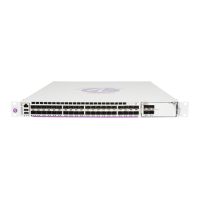IP Router Command Reference
94 7705 SAR OS Router Configuration Guide
ECMP (Equal-Cost Multipath Protocol) refers to the distribution of packets over two or more outgoing
links that share the same routing cost. ECMP provides a fast local reaction to route failures. ECMP is
supported on static routes and dynamic (OSPF, IS-IS, and BGP) routes.
ECMP can only be used for routes with the same preference and same protocol. See the static-route
command for information on preferences.
When more ECMP routes are available at the best preference than configured in max-ecmp-routes,
then the lowest next-hop IP address algorithm is used to select the number of routes configured in
max-ecmp-routes.
The no form of the command disables ECMP path sharing. If ECMP is disabled and multiple routes
are available at the best preference and equal cost, the route with the lowest next-hop IP address is
used.
The no form of the command disables ECMP path sharing.
Default no ecmp
Parameters max-ecmp-routes — the maximum number of equal cost routes allowed on this routing table
instance, expressed as a decimal integer. Setting ECMP max-ecmp-routes to 1 yields the same
result as entering no ecmp.
Values 0 to 8
allow-icmp-redirect
Syntax [no] allow-icmp-redirect
Context config>router
Description This command allows or drops ICMP redirects received on the management interface.
router-id
Syntax router-id ip-address
no router-id
Context config>router
Description This command configures the router ID for the router instance.
The router ID is used by OSPF and BGP in the routing table manager. IS-IS uses the router ID as its
system ID. Refer to the 7705 SAR OS Routing Protocols Guide for information on OSPF, IS-IS, and
BGP.
When configuring a new router ID, protocols are not automatically restarted with the new router ID.
The next time a protocol is initialized, the new router ID is used. This can result in an interim period
when different protocols use different router IDs.

